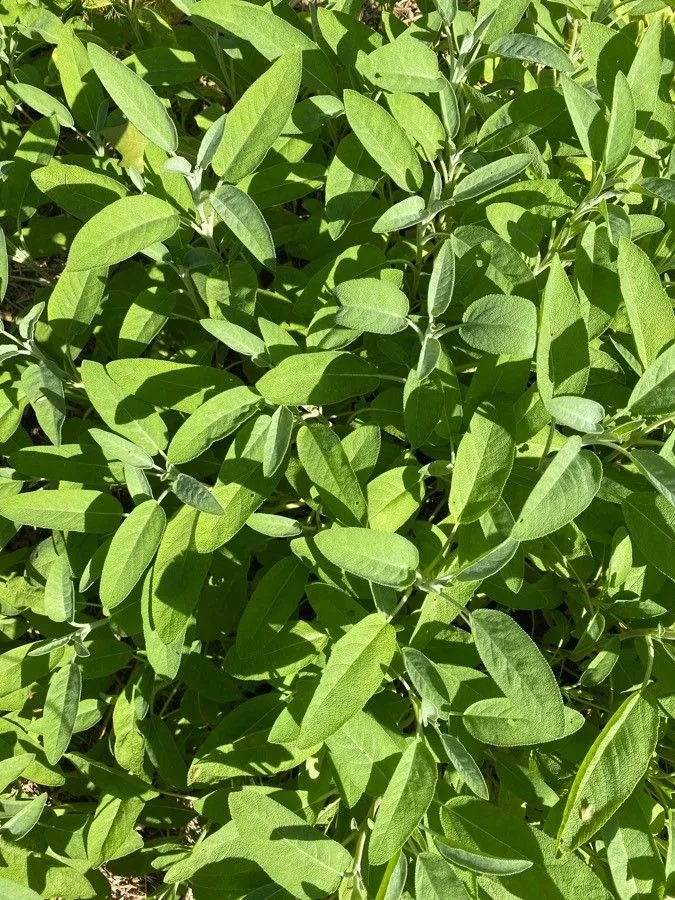
Author: L.
Bibliography: Sp. Pl.: 23 (1753)
Year: 1753
Status: accepted
Rank: species
Genus: Salvia
Vegetable: False
Observations: SW. Germany to S. Europe
Sage, known scientifically as Salvia officinalis, is a perennial, evergreen subshrub recognized for its savory, slightly peppery flavor, making it a staple in culinary practices worldwide. This aromatic herb hails from the Lamiaceae family, a large family that includes many of the world’s most beloved culinary herbs.
The origins of sage can be traced to Southwestern Germany and Southern Europe, where it thrives in the rocky, well-drained soils and enjoys ample sunlight. Renowned for its hardiness, sage can often be seen flourishing in gardens and natural landscapes across these regions.
Sage’s botanical roots can be noted in Carl Linnaeus’ seminal work “Species Plantarum,” published in 1753, where it was formally described. Bearing the authority abbreviation “L.” ascribed to Linnaeus, the species’ classification has stood the test of time, supported by centuries of use both in traditional medicine and modern kitchens.
Beyond its culinary applications, where it is commonly used to season meats, sauces, and stuffing, sage holds a valued place in herbal medicine. Its leaves are rich in essential oils, which are believed to have anti-inflammatory, antimicrobial, and antioxidant properties. Historically, sage has been utilized to treat a variety of ailments, from sore throats to digestive issues, reflecting its versatility and enduring reputation as a healing herb.
In addition to its usage in food and health, sage also offers aesthetic value in home gardens, where it adds both fragrance and visual appeal with its soft, grey-green leaves and spikes of violet or blue flowers. Whether cultivated for its practical uses or simply its beauty, Salvia officinalis remains a beloved and multifaceted herb admired across the globe.
Por: chá-da-grécia, sálvia-comum, sálvia-das-boticas, salva, salva-das-obticas, sálvia
Deu: echter salbei, garten-salbei
Eng: kitchen sage, sage, common sage, garden sage
Dan: læge-salvie
Fra: sauge officinale, sauge
Swe: kryddsalvia
Hun: orvosi zsálya
Spa: salvia real, mermasangre, salvia, salvia fina
Ces: šalvia lekárska, šalvěj lékařská
Nld: echte salie
Cym: ceidwad, saets
Rus: salfej aptečny
En: Sage, Kitchen sage, Common Sage, Garden sage, Broadleaf Sage, Berggarten Sage, Golden Sage, Holt’s Mammoth Sage, Purple Garden Sage, Tricolor Sage, West Indian sage, Purple sage
Af: Maksalie, Salie
Sq: Sherebela
Ar: مريمية, Salima, Marameeah, Maramiah, Marimih, Maryamiya, Miraamih, Salmya, مرمية, مريميه, ميراميه, مَرَمِيَة
Az: Dərman sürvəsi
Be: Шалфей аптэчны
Bs: Kadulja
Bg: Градински чай
Ca: Sàlvia, Sàlvia oficinal
Zh: Sa er wei ya, 鼠尾草
Kw: Sawja
Hr: Kadulja
Cs: Šalvěj lékařská, Šalvia lekárska
Da: Læge-Salvie
Nl: Echte salie, Franse salie, Tuinsalie, Blauwe Salie
Eo: Oficina salvio
Et: Aedsalvei
Fi: Ryytisalvia
Fr: Sauge, Sauge officinale, Herbe sacrée, Sauge de Dalmatie, Thé de la Grèce
De: Echter Salbei, Heilsalbei, Garten-Salbei, Gartensalbei, Salbei
El: Φασκόμηλο
He: מרווה
Hu: Orvosi zsálya
Io: Salvio
Ga: Sáiste
It: Salvia domestica, Salvia officinale, Salvia
Kk: Дәрілік шалфей
Ko: Yagbulkkot, Sareubia, 세이지
Lv: Ārstniecības salvija
Lt: Vaistinis šalavijas
Lb: Salbei
Mk: Обична жалфија
No: Tesalvie
Oc: Sauvi, Sauvia, Sàlvia
Os: Мыдгæрдæг
Ps: مريم گلي
Fa: مریمگلی
Pl: Szałwia lekarska
Pt: Sálvia, Betónica, Salva, Salva-rubra, Chá-da-Grécia, Sálvia-comum, Sálvia-das-boticas, Salva-das-obticas, Chá-da-Europa;, Salva-mansa
Qu: Q’uwa
Ro: Salvie
Ru: Šalfej aptečny, Шалфей лекарственный, Salfej Aptečny
Sr: Жалфија
Sk: Šalvia lekárska
Es: Salvia real, Mermasangre, Salvia fina, Salvia, Žajbelj, Salvia común
Sv: Kryddsalvia
Zh-tw: 鼠尾草
Zh-hant: 鼠尾草
Tr: Tıbbi ada çayı
Uk: Шавлія лікарська
Ur: مریم گلی
Vi: Xô thơm
Wa: Franke saedje
Cy: Saets, Ceidwad
© copyright of the Board of Trustees of the Royal Botanic Gardens, Kew.
© copyright of the Board of Trustees of the Royal Botanic Gardens, Kew.
© copyright of the Board of Trustees of the Royal Botanic Gardens, Kew.
Taken Oct 7, 2021 by Jacques Zuber (cc-by-sa)
Taken Dec 31, 2021 by Alberto Bushell (cc-by-sa)
Taken May 31, 2020 by Sabrina Olaru (cc-by-sa)
Taken Sep 23, 2020 by Anthony Bernard (cc-by-sa)
Taken Sep 23, 2020 by Anthony Bernard (cc-by-sa)
Taken Aug 31, 2021 by Jacques Zuber (cc-by-sa)
Taken Jul 12, 2018 by Renaud Brochiero (cc-by-sa)
Taken May 15, 2018 by 1 (cc-by-sa)
Taken Oct 7, 2021 by Jacques Zuber (cc-by-sa)
Taken May 31, 2020 by Sabrina Olaru (cc-by-sa)
Taken Apr 23, 2017 by Pep Secem (cc-by-sa)
Taken Oct 17, 2017 by Youn Dead (cc-by-sa)
Taken May 15, 2018 by 1 (cc-by-sa)
Taken May 15, 2018 by 1 (cc-by-sa)
Taken Sep 24, 2018 by Manu Pacha (cc-by-sa)
Taken Dec 1, 2021 by Rober Steve (cc-by-sa)
Taken Nov 29, 2019 by Caroline Bourdillon (cc-by-sa)
Taken Aug 27, 2021 by Jacques Zuber (cc-by-sa)
Taken May 1, 2014 by Tela Botanica − Jean-Claude ECHARDOUR (cc-by-sa)
Taken Aug 29, 2019 by kasper (cc-by-sa)
Taken Aug 13, 2021 by Gérard GRÉGOIRE (cc-by-sa)
Taken May 23, 2012 by Tela Botanica − Yoan MARTIN (cc-by-sa)
Taken Nov 29, 2021 by Grumo Bio (cc-by-sa)
Taken Jan 29, 2022 by Fabien Anthelme (cc-by-sa)
Taken Jan 15, 2021 by Jessica Gobey (cc-by-sa)
Taken Aug 27, 2022 by Lilian Dieben (cc-by-sa)
Taken Aug 21, 2019 by bonzo bonzo (cc-by-sa)
Taken Nov 22, 2020 by Didier Maury (cc-by-sa)
Taken Nov 6, 2020 by Claude Aggery (cc-by-sa)
Taken Apr 1, 2020 by minerva daniele79 (cc-by-sa)
Growth habit: Subshrub, Shrub, Forb/herb
Ph maximum: 8.0
Ph minimum: 7.5
Light: 7
Atmospheric humidity: 4
Soil nutriments: 2
Family: Myrtaceae Author: (F.Muell.) K.D.Hill & L.A.S.Johnson Bibliography: Telopea 6: 402 (1995) Year: 1995 Status:…
Family: Rubiaceae Author: Pierre ex A.Froehner Bibliography: Notizbl. Bot. Gart. Berlin-Dahlem 1: 237 (1897) Year:…
Family: Sapindaceae Author: Koidz. Bibliography: J. Coll. Sci. Imp. Univ. Tokyo 32(1): 38 (1911) Year:…
Family: Asteraceae Author: A.Gray Bibliography: Pacif. Railr. Rep.: 107 (1857) Year: 1857 Status: accepted Rank:…
Family: Fabaceae Author: Medik. Bibliography: Vorles. Churpfälz. Phys.-Ökon. Ges. 2: 398 (1787) Year: 1787 Status:…
Family: Aspleniaceae Author: (Cav.) Alston Bibliography: Bull. Misc. Inform. Kew 1932: 309 (1932) Year: 1932…